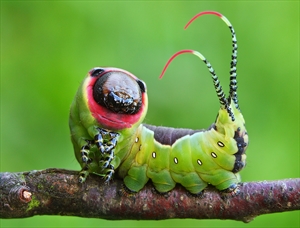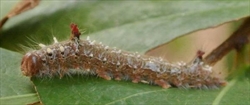Background
The Notodontidae, belonging to the superfamily Noctuoidea, is a relatively small family of Lepidoptera of approximately 3,800 known species worldwide, but occurs mostly in tropical areas. There are 81 described species in Australia but the family is absent from New Zealand. Moths in this family tend to be moderately sized to large with robust, heavy bodies. Adults do not feed. The caterpillars are known for their often bizarre appearances (Fig. 1). They tend to be arboreal insects and sometimes cause defoliation of their hosts.
Subfamilies
The following subfamilies are supported to some extent by Regier et al. 2017 and previous studies. But there is much uncertainty in the systematics at this level as many of the subfamilies appear to be polyphyletic according to that study.
- Thaumetopoinae
- Heterocampinae
- Notodontinae
- Phalerinae
- Roseminae
- Hemicratinae
- Ptilophorinae
- Pygaerinae
- Dicranurinae
- Cerurinae
- Dudusinae
- Nystaleinae/Dioptinae
Short Description
Adapted from Stehr et al. (1987), Weller (1992), Kitching & Rawlins (1998).
The mature caterpillars are medium to large in size, generally not hairy and are often striking because of colours (Fig. 1), patterns and also eversible glands (Fig. 2) coupled with defensive postures. The head is round (Fig. 2, Fig. 3) or may appear to be flattened (Fig. 1) with slightly elongated epicranial vertices. The body can be plainly cylindrical, or may have distinct protuberances in the shape of ‘horns’, humps and tubercles (Fig. 3). The body may taper significantly posteriorly with modified anal prolegs called stemapods (Fig. 1). The integument is generally relatively smooth (Fig. 1, Fig. 2), with indistinct granules and may sometimes appear glossy or covered with spinules. There may be extra secondary setae on the lateral faces of the prolegs A3-6. Dorsally there are either single, primary setae, or sometimes abundant secondary setae uniformly distributed (Fig. 3). Sometimes, dorsal of the prolegs, there are multisetose, paired verrucae (Fig. 3). The body shows a very wide diversity of bold or cryptic patterns including spots and stripes. Spiracles are elliptical, with that on T1 and A8 usually larger than those on A1-A7.
Most notodontid caterpillars are solitary feeders, but some are gregarious, and this is most common in the processionary moths, the Thaumetopoinae.
Diagnosis
Adapted from Stehr et al. (1987), Miller (1991), Kitching & Rawlins (1998), Schintlmeister (2008).
The main diagnostic features for the Notodontidae are as follows:
- Two MD setae on A1. Other Noctuoidea have only one
- Seta X in the anterolateral corner of the suranal shield Most Notodontidae
- SV seta on T2 and T3 – unisetose. Most Notodontidae, but bisetose in the Heterocampinae
- The mandibular cutting edge is smooth (with no scissorial teeth) in mature larvae
- Many have a cervical gland on the mid-venter of T1, just posterior to the head. The everted gland (adenosema) is dorsoventrally flattened and bifid (except in the Dioptini) (Fig. 1, Fig. 2)
- Modified A10 prolegs
- A10 prolegs, frequently elevated when the larva is resting (Fig. 1)
- Frequently smaller than the A3-A6 prolegs or modified as stemapods, which may be peglike structures or very thin and elongated and sometimes with eversible distal glands (Fig. 1)
- Crochets less numerous than on A3-A6, or absent. This character is unique in the Noctuoidea.
Other features characteristic of the family are as follows:
Head
- Stipital lobes present on the maxilla
- Mandibles bearing secondary setae. Thaumetopoinae
- Lateral flanges on spinneret. In many notodontids.
Prolegs
- Prolegs – full complement on A3-A6 (Fig. 1, Fig. 3). Separates the notodontids from the Nolidae (which have 3 pairs) and some Noctuidae and Erebidae (with only 2 or 3 pairs) (‘semi-loopers’)
- Sub-equally to equally developed A3-A6 prolegs, but these are also in the Noctuidae and Erebidae
- Uniordinal crochets, rarely biordinal (Common 1970), but also Noctuidae and Erebidae
- Crochets arranged in a homoideous mesoseries. Distinguishes notodontids from the Arctiinae (Erebidae)
- Extra, or secondary setae, at least on the A3-A6 prolegs - the SV group on lateral sides of A3-A6 prolegs. Exceptions are Clostera (Pygaerinae) (Fig. 3) and Datana (Phalerinae), in which the body is uniformly covered extensively with setae and there are secondary setae on the head. Generally, paired, multisetose verrucae are absent (unlike the Arctiinae and Lymantriinae (Erebidae) and Acronictinae (Noctuidae)). Scoli sometimes present as in Clostera (Fig. 3)
- A8 with spiracle less than 1.5X (usually about 1.25X) height of that on A7. Thaumetopoinae
- Many have chemical defences (cyanic acid, formic acid, and other ketones) not commonly found in other Lepidoptera)
- Some larvae undergo shape modification and colour changes with each instar.
Adapted from Stehr et al. (1987) and Kitching & Rawlins (1998).
Detailed Description
Head: The head is hypognathous (Fig. 1, Fig. 2, Fig. 3) with a roughly triangular to bell-shaped frontoclypeus with an apex at around 0.3-0.4 of the distance between the base of the frontoclypeus and the epicranial notch The junction of the adfrontal ecdysial lines lies distally cephalad of the epicranial notch (this description of the frontal area applies to the North American taxa at least). There are six stemmata, with 1-4 in a semicircle, and 5 and 6 forming a line ventroposterior of 1-4.
Thorax: The prothoracic shield is variously developed and may not be discernible (Fig. 3). SV group uni- or bisetose on T2 and T3; MD bisetose on T3.
Abdomen: The MD setae are bisetose on A1 (Hinton 1946) and the SV group has more than three setae on prolegs A3-A6. The prolegs are subequally to equally developed on A3-A6 (Fig. 1, Fig. 3), with homoideous, uniordinal crochets in a mesoseries. The A10 prolegs are often reduced (stemapods) and are shorter or peglike, with fewer crochets than on A3-A6, or tapering and elongated with no crochets (Fig. 1).
The dorsal surfaces of A1-A8 are unmodified, or with at least one or several segments bearing single or double tubercles and/or humps. The humps may be very large and movable. Setae-bearing verrucae and scoli are present in some species (Fig. 3), especially the Pygaerinae.
The A10 segment has an extra seta near the anterolateral corner of the anal shield (suranal plate) but this is absent in Cargida (Dudusinae) and undiscernible in some last instar Datana (Phalerinae) and Clostera (Pygaerinae) (occurs in Australia) (Fig. 3), which have abundant secondary setae. The anal shield (suranal plate) is generally convex, with the posterior margin rounded in the dorsal view or variously flattened and rather angular in the dorsal view in some species with long filamentous A10 prolegs (Fig. 1).
Mature larvae can differ markedly in appearance from early instars.
Species of Biosecurity Concern
THE FOLLOWING SPECIES IS OF BIOSECURITY CONCERN TO NORTHERN AUSTRALIA
Neostauropus alternus, or lobster caterpillar, is considered to be of biosecurity concern for northern Australia. It is an Asian species and is considered to be a pest on pulses, tea, coffee, rambutan and mango.
Neostauropus alternus (lobster caterpillar) (Notodontidae: Notodontinae)
This species was separated into Neostauropus from Stauropus by Kiriakoff (1967).
Description
Adapted from Holloway (1983), Leong (2008).
For images, see: https://lkcnhm.nus.edu.sg/app/uploads/2017/06/2008nis159-164.pdf
Mature caterpillars are brown, with white and yellow patches and dark streaks and spots. The head is much higher than wide. The thorax is narrow. The second and third pairs of thoracic legs are must longer than the first. A1-A6 have paired conical processes. A7 has a ventrolateral tooth and tubercle on each side. A7 and A8 are flattened ventrally. A8 is expanded laterally and is strongly convex dorsally. The ventral prolegs are long. The anal claspers (prolegs) are elevated when the larva is resting, and are reduced to two slender, angular processes (stemapods).
Biology and Feeding Damage
At rest, the mature caterpillar generally rests upside down while clinging to the substrate with the ventral prolegs and with its head and thorax and posterior segments in close proximity. When feeding the caterpillar grips the leaf with its thoracic legs and eats from the outer margin inwards, while tapping the leaf with its legs. When disturbed the caterpillar flings its legs outwards and then vibrates them for a few seconds before folding them in. Simultaneously it also suddenly parts the anal prolegs (Leong 2008)). The caterpillars are believed to be ant mimics.
Current Distribution
- North-eastern Himalayas
- Sri Lanka
- Sundaland
- The Philippines
- Sulawesi
- Southern Moluccas
Caterpillar Host Plants
- tea (Camellia sinensis)
- coffee (Coffea)
- rambutan (Nephelium lappaceum)
- mango (Mangifera)
- castor bean or castor oil plant (Ricinus)
- Careya
- Cajanus
- cassias (Cassia)
- tick-trefoil, tick clover, hitch hikers or beggar lice (Desmodium)
- blackbeads (Pithecellobium)
- Wagatea
- wattle (Acacia)
References
Miller, J.S. (1991) Cladistics and classification of the Notodontidae (Lepidoptera: Noctuoidea) based on larval and adult morphology. Bulletin of the American Museum of Natural History, 204: 1–230.
Holloway, J. (1983) Neostauropus Kiriakoff. The Moths of Borneo. Notodontidae. http://www.mothsofborneo.com/part-4/neostauropus/notodontidae_33_1.php. Retrieved 3 October 2019.
Kiriakoff, S.G. (1967). Lepidoptera familia. Notodontidae Pars seconda Genera Palaearctica. Genera Insectorum, 217: 1-238 [89].
Kitching, I. J. & Rawlins, J. E. (1998) Noctuoidea. Handbook of Zoology. Lepidoptera, Vol. 1: Systematics and Evolution (ed. by N.P. Kristensen), pp. 355–401. W. de Gruyter, Berlin.
Leong, T. M. (2008). Last instar caterpillar and metamorphosis of Neostauropus alternus (walker) (Lepidoptera: Notodontidae). Nature in Singapore, 1: 159–164
Regier JC, Mitter C, Mitter K, Cummings MP, Bazinet A, Hallwachs W, Janzen DH, Zwick A. (2017). Further progress on the phylogeny of Noctuoidea (Insecta: Lepidoptera) using an expanded gene sample. Systematic Entomology, 42: 82–93.
Schintlmeister, A. (2008) Notodontidae. Palaearctic Macrolepidoptera, Vol. 1. Apollo Books, Stenstrup.
Stehr, F.W., Martinat, P.J., Davis, D.R., Wagner, D.L., Heppner, J.B., Brown, M.E., Toliver, M.E., Miller, J.Y., Downey, J.C., Harvey, D.J., McFarland, N., Neunzig, H.H., Godfrey, G.L., Habeck, D.H., Appleby, J.E., Jeffords, M., Donahue, J.P., Brown, J.W. & Frack, D.C. (1987) Order Lepidoptera, pp 288–596. In Stehr, F. W. (Ed.), Immature Insects. Kendall/Hunt, Dubuque.
Weller, S.J. (1992) Survey of adult morphology in Nystaleinae and related Neotropical subfamilies (Noctuoidea: Notodontidae). Journal of Research on the Lepidoptera, 31: 233–277.




